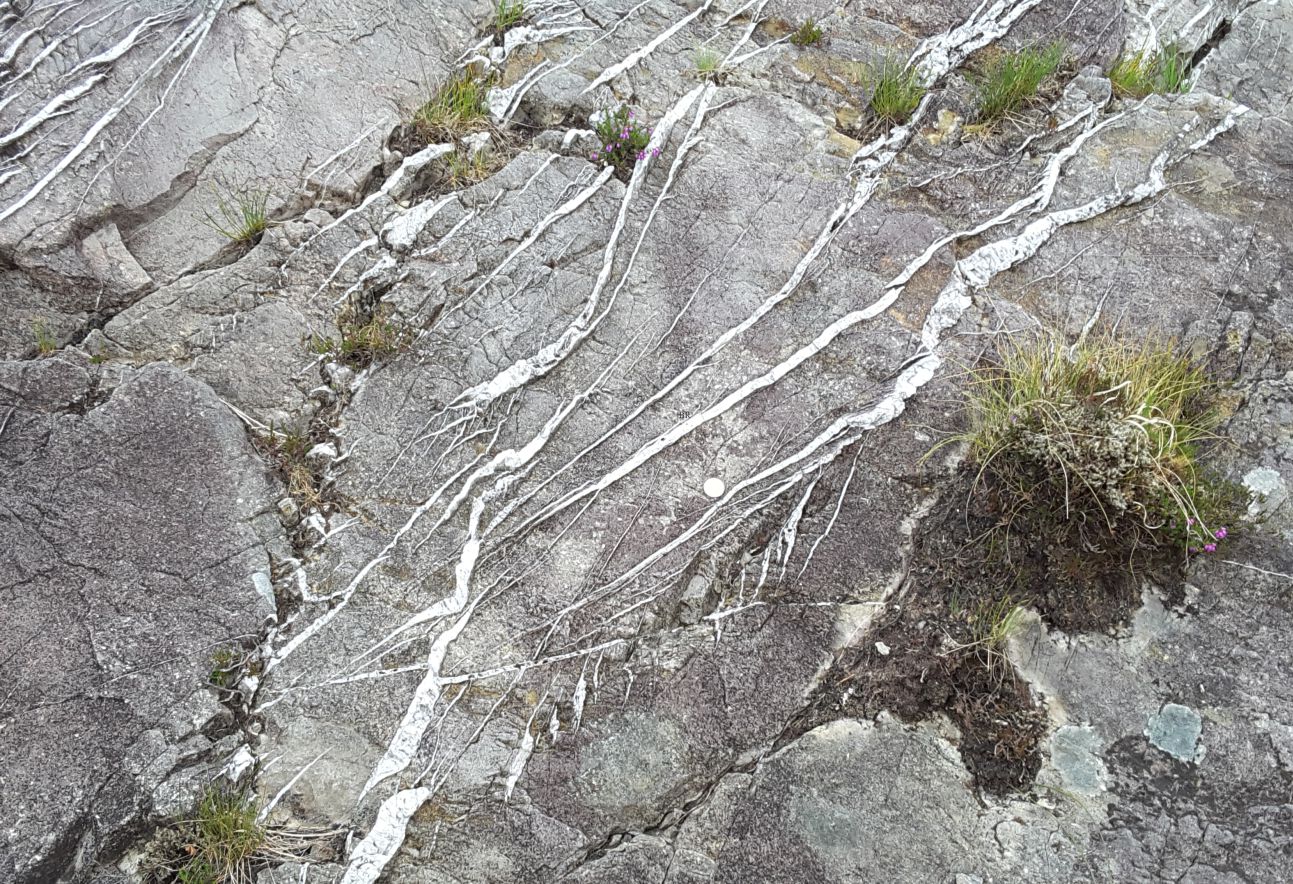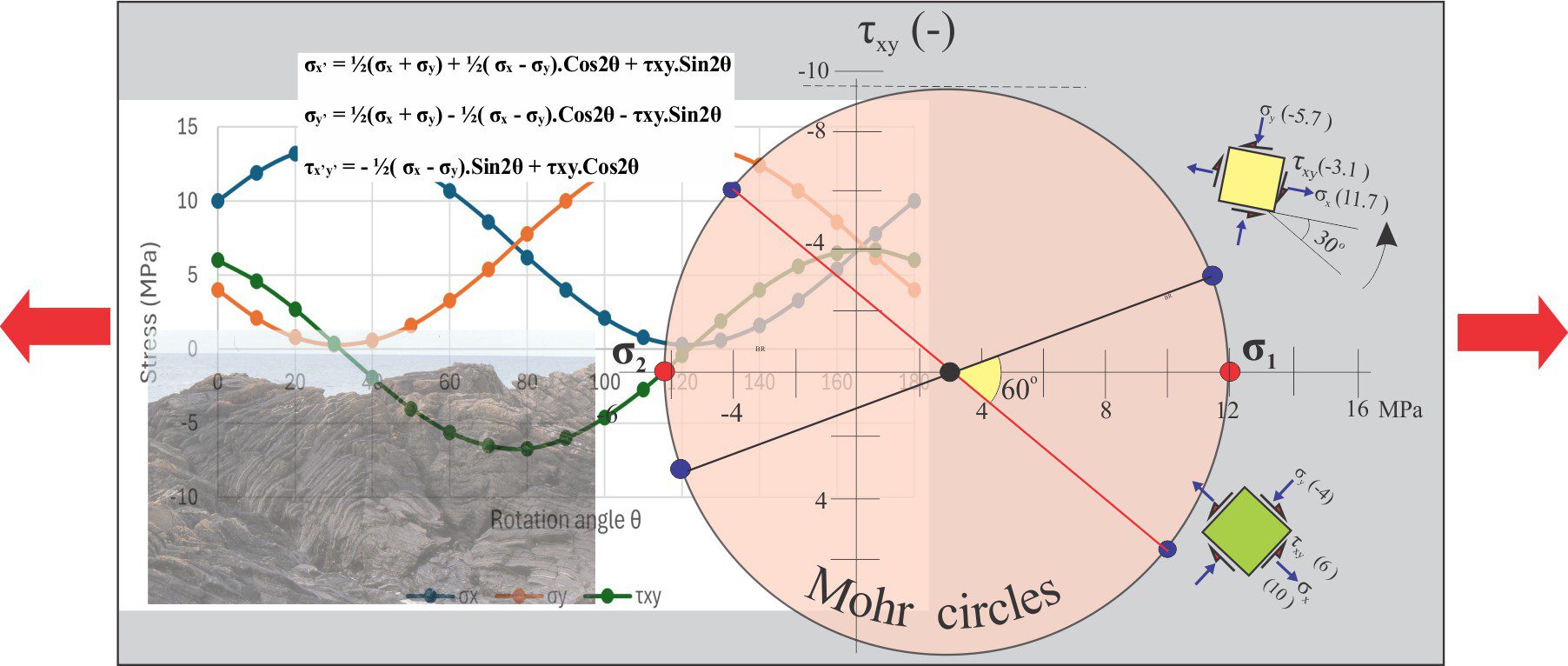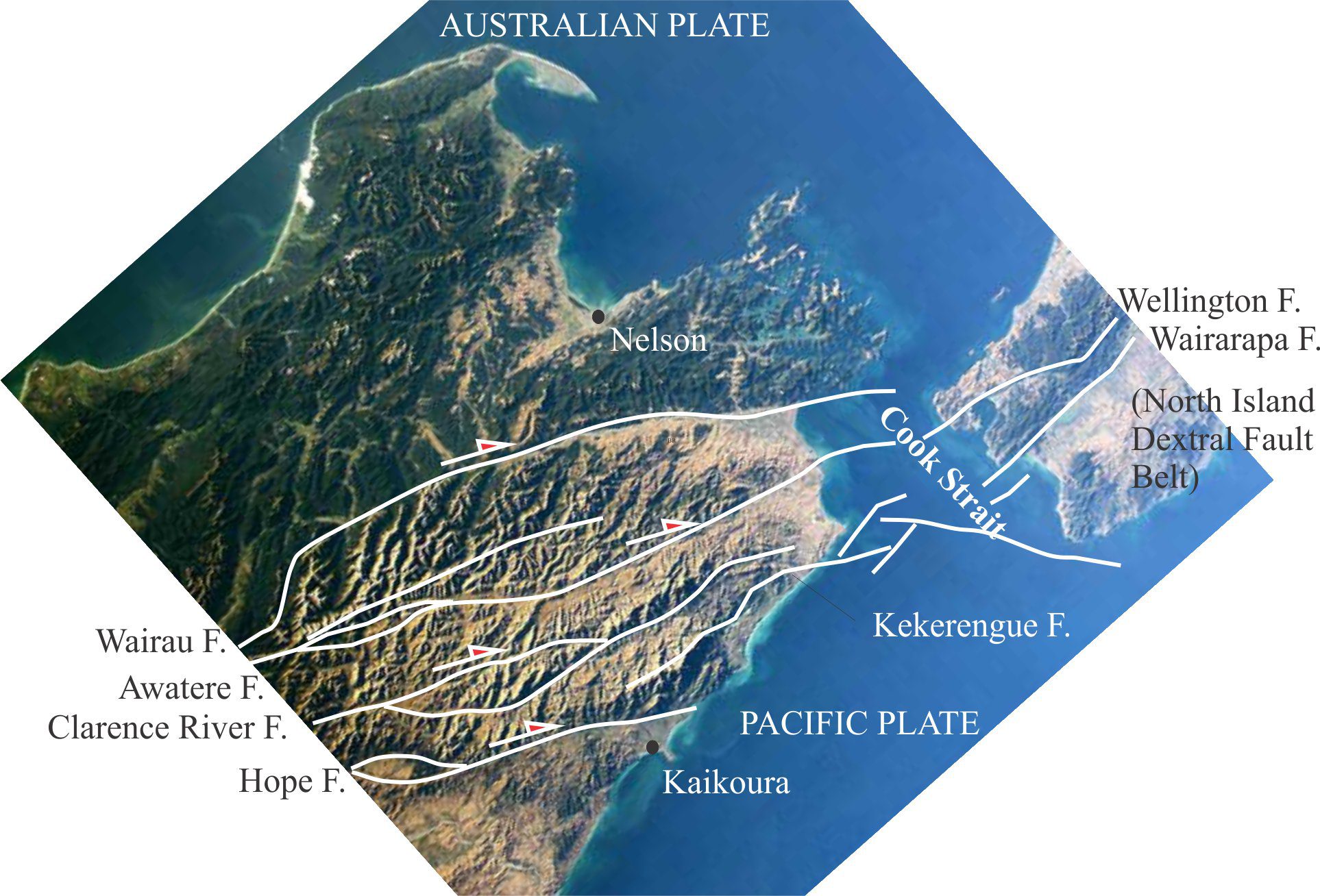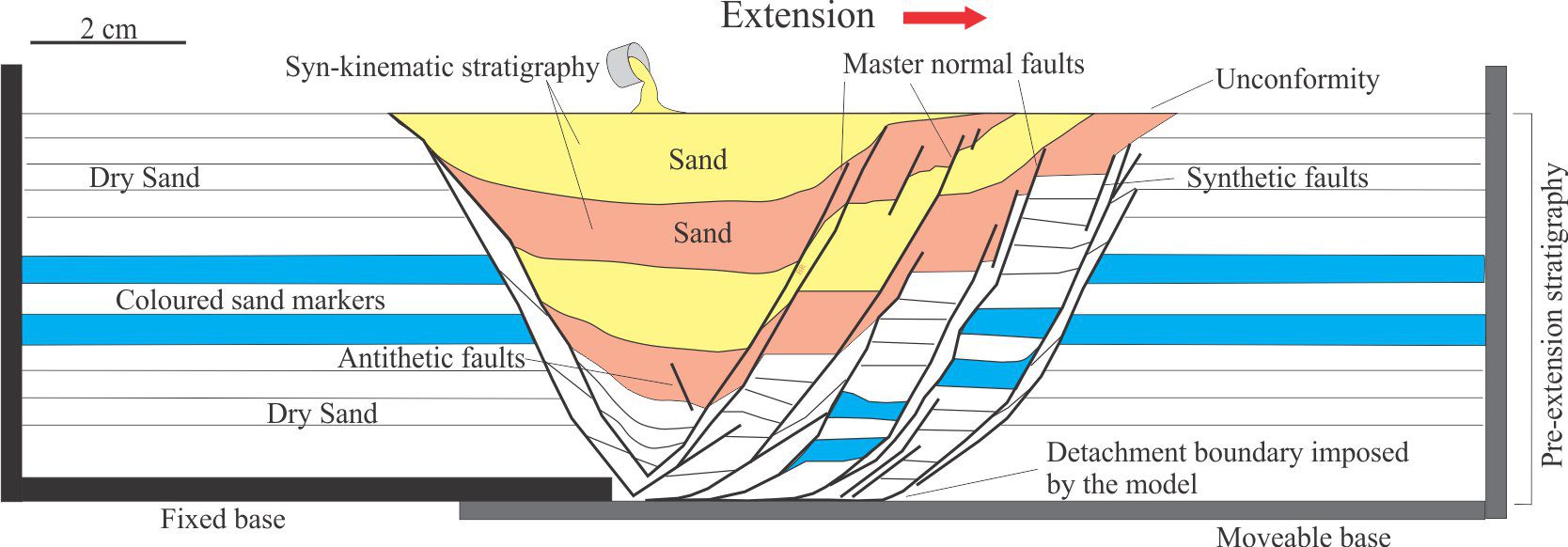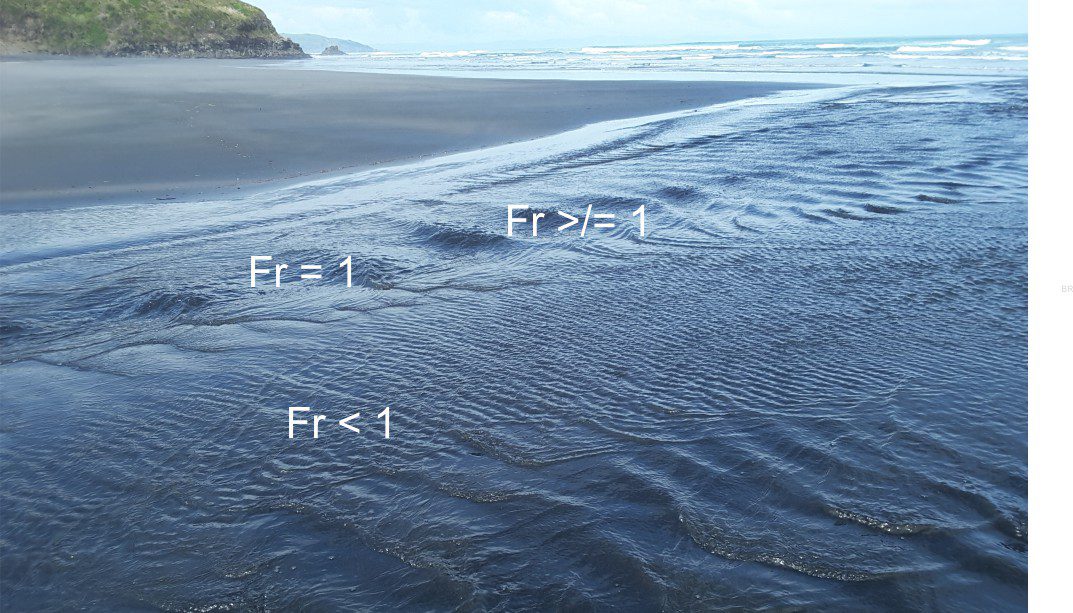 Please note – I no longer maintain Glossaries by alphabet; A, B, C… etc. All items on these pages have been moved to subject-specific glossaries such as Volcanology, Sedimentary facies and processes, and so on. The list of subject-based glossaries can be viewed in the drop-down menu on the navigation bar. These glossaries are continually updated.
Please note – I no longer maintain Glossaries by alphabet; A, B, C… etc. All items on these pages have been moved to subject-specific glossaries such as Volcanology, Sedimentary facies and processes, and so on. The list of subject-based glossaries can be viewed in the drop-down menu on the navigation bar. These glossaries are continually updated.
P & S waves (seismology): Seismic body waves generated by an impulse (earthquake, TNT, meteor impact) that travel through Earth from the energy source. P waves push and pull materials in the same direction as the propagated waves (also called compressional waves). S waves, or shear waves produce sideways motion – motion at right angles to the propagation direction. Shear waves do not travel through liquid. P waves travel fastest (up to 7.97 km/sec in upper mantle rocks) and are the first to appear on a seismogram. See also Surface waves.
Packstone: A clast-supported limestone framework with >90% of clasts finer than 2 mm (upper limit of coarse sand). Dunham’s (1962) limestone classification scheme reviewed and modified by Lockier and Junaibi (2016).
Pahoehoe flows: Relatively fluid lavas that develop smooth, ropy, billowing or tendril-like textures across the flow top. They occur mostly in basaltic lavas, and are commonly associated with tumuli and spatter cones. Pahoehoe flows also advance by budding and lava breakout. Highly mobile flows can move at speeds up to 40 km/hour.
Paleocurrent: The direction of flow and sediment transport in ancient environments can be estimated from directional sedimentary structures such as crossbeds and sole marks, and from mapped facies changes such as grain size trends. The strength of paleocurrents can also be approximated by the size of bedform, and the size or density of clasts. Paleocurrent analysis is basically an exercise in statistics where flow directions are expressed as means.
Paleoslope: An ancient depositional surface that has a dip referenced to established datums such as ancient shorelines or shelf-platform margins, and in terrestrial settings the regional drainage patterns.
Paleosol: The general name for all manner of paleo-soils. Their identification in the rock record adds considerable value to assessment of subaerial exposure, unconformities, and paleoclimates.
Paleothermometer: Geological, paleontological and chemical tools used to determine the temperature conditions and thermal history of ancient environments, and more deep-seated processes associated with sedimentary basins, igneous and metamorphic events. They are components of rocks such as minerals, isotopes, fossils, and fluids that provide us with either a direct measure or proxies of paleotemperatures. Common examples include vitrinite reflectance of coals, fossil colour, radiogenic blocking temperatures, stable isotopes of oxygen and carbon, fission tracks, and fluid inclusions.
Palm tree structures: See flower structures.
Palynomorphs: A group of microscopic animal and plant structures composed of resistant organic compounds. The animal representatives comprise a significant part of the plankton biomass, and include dinoflagellates, chitinozoans, and acritarchs. The plant side includes well known pollen and spores. They have biostratigraphic significance. Pollen and spores provide paleoenvironmental and biostratigraphic information on terrestrial environments. Colour alteration of pollen and spores can also be used to determine the thermal history of sedimentary basins.
Panspermia: The speculative idea that life, or the ‘seeds’ of life evolved elsewhere in the universe, and were delivered to Earth, presumably by asteroids and comets. The term ‘seeds’ includes important biochemical ingredients like DNA. The idea in general has not progressed beyond speculation.
Paragenetic sequence: In sedimentary petrology, the sequence of mineral components precipitated (and dissolved) during diagenesis. Sequential changes in mineral composition and/or crystallographic form reflect evolving fluid compositions, fluid flow, burial temperatures, and compaction. It is analogous to cement stratigraphy.
Paralic: Coastal environments (and their deposits) that are characterised by interfingering shallow marine and non-marine conditions. It includes deltas (delta plains, interdistributary bays, and channels), lagoons, and estuaries. Paralic systems are susceptible to even minor changes in sea level and sediment supply, recorded for example as shoreline trajectories. They are stratigraphically important because they record the transition from fully marine to terrestrial.
Parasequence: A relatively conformable succession of genetically related beds bounded by marine flooding surfaces. Parasequences represent relatively short-lived, cyclical periods of progradation that are superimposed on or punctuate 3rd order regressive or transgressive cycle trends. They are the stratigraphic building blocks of shallow marine systems tracts, forming under conditions of normal and forced regression, and transgression depending on the rates of sediment supply versus the rates of change of accommodation.
Parasequence set: A stack of parasequences that are genetically related; in other words, parasequences that show consistent trends through a stratigraphic succession, and consistent shoreline trajectories that are progradational, aggradational, retrogradational, or degradational. Stated another way, a parasequence set is a cycle made up of higher-order cycles.
Parasitic folds: Small-scale asymmetric folds that form on the limbs of larger folds. They are common in deformed rocks where flexural slip takes place along bedding planes or between layers with contrasting strength, such as mudstone and indurated sandstone. Parasitic folds are useful indicators of the geometry and orientation of their larger fold hosts – they have the same fold axis orientation. Their geometry and sense of displacement define S and Z folds on either limb of the main structure. S and Z fold vergence is towards to main fold hinge line; The short limb of a Z fold implies counterclockwise rotation, and on an S fold it is clockwise.
Partial melting: Most rocks consist of several minerals, each of which has a different melting point. When rocks begin to melt, those minerals with the lowest melting points will be the first to contribute to magmas – the rock will be partially melted, producing a kind of crystal mush. Partial melting is a critical stage of magma formation in the mantle. See Flux melting.
Particulate flow: Faulting of soft, non-indurated sediment results in grain rolling and sliding along the fault plane – fault core. This process changes the grain packing geometry and permeability compared with the host sediment.
Parting lineation: A crudely linear pattern of rock breakage, usually seen only in bedding plane exposure of laminated sandstones. It is attributed to high flow velocities where the long axes of sand grains become aligned. Measured current directions are ambiguous.
Passive margins: Thick sedimentary wedges or prisms that border the trailing edge of continental margins during sea floor spreading. They present as shelves, platforms, and plateaus, with a continental slope at the seaward transition to ocean basins and oceanic crust. Passive margins follow directly on the heels of continental rifting, once stretching has ceased; there is commonly a major unconformity between the rift and passive margin succession, called a breakup unconformity. Subsidence is primarily a flexural response to lithospheric cooling (once mantle heating has been turned off), aided by a sediment load that can be more than 10 km thick. Depositional systems cover the gamut of siliciclastic and carbonate environments.
Passive rifting: Rift basins formed by stretching and extension of the lithosphere in response to stress fields generated by far-field plate motions. The rise of mantle plumes is a passive response to extension. Cf. Active rifting.
Passive roof thrust: A thrust that takes no part in displacement but develops passively during underthrusting or wedge insertion. Roof thrusts of triangle zones are commonly passive.
Patterned ground: Characteristic surface structures in seriously cold, periglacial regions, particularly tundra and other regions underlain by permafrost. The patterns include symmetrical polygons, stripes and circles that have diameters generally <10-15 m, although some patterns are >100 m. Collectively, the patterns may covers many square kilometres. Their formation is related to cryogenic processes such as freeze-thaw expansion and contraction, frost heave, and ice wedging. They have also been observed on Mars.
PDC: The acronym for Pyroclastic density current
Peléan eruption: Explosive eruptions in moderately viscous rhyolite-andesite magma, that produces a relatively low eruption column, not unlike Vulcanian types. However, Peléan eruptions are noted for the large, glowing, pyroclastic flows that develop from the collapse or explosive disintegration of a viscous lava dome. Named after the eruption of Mt. Pelée in 1902.
Pelloids: Any spheroidal, sand sized grain that is an aggregate of micro- to cryptocrystalline carbonate. There is little or no internal structure. If they are known to be fecal then they are called pellets. Otherwise, the term pelloid should be used.
Pendant cement: Stalactite-like cements that accumulate on the low point of grains during gravity drainage of interstitial fluid. They are common in carbonates subjected to vadose zone diagenesis.
Peperite: A mix of brecciated lava and sediment, formed by the explosive injection of magma into water-saturated sediments. Brecciation is partly due to rapid quenching, and to forcible injection of superheated steam. They occur where basaltic lavas flow across lake beds or swamps and partly intrude their sediments.
Pericline twins: A common twin in plagioclases and potassium feldspars. Twins are commonly multiple, parallel laminae, similar to albite twins but oriented at different angles, commonly at 90o to albite twins.
Pericratonic terrane: A terrane on attenuated continental lithosphere and sandwiched between the craton and surrounding allochthonous terranes, in which sediment is partly derived from the craton and neighbouring terranes.
Peripheral bulge: See forebulge
Periglacial environments: Cold environments associated with glaciers and ice sheets, that are subject to seasonal freeze and thaw. Some periglacial regions are underlain by permafrost. Most contain some kind of vegetation and organic soil cover, that is modulated by perennial snow cover. Common landforms include patterned ground, ice wedges, melt-water ponds, fluvial channels of varying sinuosity, small fan deltas or Gilbert deltas, and thermokarst.
Permafrost: Ground that remains frozen for at least 2 years. It consists of soil, sediment, and fractured bedrock bound by ice. It may also include methane clathrates, and significant volumes of dispersed organic carbon. Shallow melting of permafrost produces thermokarst.
Permeability: A measure of the ease with which fluids flow through porous sediment and rock. In groundwater studies it is expressed as hydraulic conductivity that has dimensions of distance/time. The hydrocarbon industry uses a dimensionless number for intrinsic permeability, the Darcy, that depends only on the porous medium. The unit reduces mathematically to units of area (ft2, m2). It is basically a measure of pore size.
Permeameter: A simple lab device for measuring hydraulic conductivity (K). It consists of a tube-like chamber for a sediment or rock sample, and a water reservoir that bleeds water into the chamber. The device measures the rate at which water seeps through the sample. A simple calculation of K is K = VL/Ath where V is volume discharged per time t, L the length of sample of cross-section area A, and h is the hydraulic head.
Perthites: One of the key identifiers of potassium feldspars under a polarizing microscope is perthitic texture, which is a mix of two different exsolution feldspar phases – albite and orthoclase. Exsolution occurs during crystallization from the melt.
Petrography: Is the description of sediments and rocks; their colour, hardness, texture, mineral and chemical composition, and fabric. Petrography provides a focal point petrologists.
Petrology: Is the study of the origin of sediments and rocks, the physical, chemical, and organic conditions and processes that lead to their formation.
pH: Literally the ‘potential of hydrogen’, is a measure of the acidity or alkalinity of an aqueous solution. It is expressed as:
pH = -Log10 (aH+) where aH+ is the activity of H+ in solution.
This means that high concentrations of H+ have low pH values. The pH range is 0 to 14; a neutral solution has pH = 7. An acidic solution has a pH <7.0; an alkaline solution >7.0. Pure water at 25oC has a pH of 7; rain a pH of 5.0 to 5.5 (i.e. slightly acidic because of dissolved CO2), and seawater 7.5 to 8.1. The variations are partly dependent on temperature and its influence on the carbonate equilibria.
pH buffering: Carbonate equilibria do not operate in isolation. If the amount of dissolved CO2(aq) is increased this does not mean that the amount of H+(aq) will increase by the same amount because some of the CO2 forms H2CO3 (aq), some HCO3– (aq), and some CO32- (aq), such that the amount of H+ added is small. In other words, the cascade of equilibria acts to buffer the system against large changes in pH.
Phaneritic: A general term to describe volcanic and intrusive rocks where individual crystals can be see without the aid of a microscope. Cf. Aphanitic.
Phase diagram: The graphical representation of different states for a compound, as solid, liquid, or gas. The phase diagram for water is plotted as pressure against temperature; the triple point where all three phases coexist is at 0.01oC and 608 pascals (0.006 atmospheres). For carbon dioxide the diagram also shows gas, solid and liquid phases, plus a supercritical liquid phase.
Phenocryst: Conspicuous, relatively large crystals in igneous rock, particularly in volcanics where they can easily be distinguished from groundmass. A rock that has lots of phenocrysts is described as porphyritic.
Phi scale A linear grain size scale based on the logarithm (to base 2) of the size in millimetres, devised by W.C. Krumbein; Φ = -Log2. Negative values of Phi apply to all grain sizes greater than one millimetre that, on the Wentworth scale, subdivides coarse from very coarse sand. Phi values smaller than 1 mm are positive. Phi values have proven to be useful for calculating statistical parameters such as mean and standard deviation (sorting).
Photosynthesis: A process that converts sunlight energy to chemical energy in plants, cyanobacteria, and algae. One of the chemical products is molecular oxygen(O2), that in plants is formed from carbon dioxide reacting with water in plant cells to produce sugars and oxygen. It is generally understood that most of Earth’s free oxygen was produced during the Precambrian by cyanobacterial stromatolites.
Photic zone: The uppermost layer of the oceans and lakes where light penetrates; the base of the zone is at about 1% of incident sunlight. On average it is about 200 m deep. It is the layer where more than 95% of photosynthesis by marine organisms takes place.
Phreatic eruptions: Explosive eruptions where rock heated by magma comes into contact with groundwater or seawater, but does not involve new magma (i.e. the magma itself is not incorporated into the eruption). Hyaloclastites are a common product of this eruption type.
Phreatomagmatic eruption: Explosive eruptions where rising magma comes into contact with water (sea-lake water, groundwater); Surtsey (Iceland) is an iconic example. Hyalotuffs are a common depositional product of phreatomagmatic eruptions. They tend to be glassy, and finer grained than magmatic eruptions because of the intense reaction between hot magma and water.
Piercing points: Identifiable marker beds, lineaments or other rock structures cut by a fault, that can be used to reconstruct the displacement or separation along that fault trace. Cf. Cut-off points that are used to determine fault slip in cross-section views.
Piezometer: An pipe, borehole, or tube that extends from some point within an aquifer and is open top and bottom. Groundwater rises to a height above the bottom of the piezometer according to the hydraulic head at that point. The height of the water level is usually measured electronically. Piezometers are used to measure directly the hydraulic head distribution both vertically and laterally in an aquifer. See nested piezometer.
Piezometric surface: A little used term, replaced by potentiometric surface.
Pillow lavas: Bulbous, spheroidal to tubular bodies of lava extruded, toothpaste-like, on to the sea or lake floor. They tend to accumulate in piles where newly formed pillows bud from, and grow around those formed earlier, creating a tight, albeit irregular packing arrangement. Pillows that become detached may roll to the base of the pile. Chilled margins may contain small pipe vesicles. The interstices between pillows usually fill with hyaloclastite fragments formed by shattering of rapidly quenched lava. Pillow lavas most commonly form in subaqueously extruded basaltic magmas but are known from other lava types. Mid-ocean spreading ridges contain humongous volumes of them.
Pipe vesicle: A narrow tube (a few mm across) that protrudes inwards or upwards from the base of a lava flow, resulting from injection of superheated steam derived from underlying soil water and vegetation.
Pisoid: Concentrically layered ovoid to markedly elongate carbonate bodies that superficially resemble oncoids. However, unlike oncoids and ooids, pisoids form in meteoric vadose conditions, commonly associated with calcretes (paleosols). Common textures include: close-fitted and intergrown pisoids (hence their shapes are irregularly elongate), evidence of multiple stages of precipitation and dissolution (commonly as cross-cutting fabrics), and gravitationally-induced pendant cements.
Pisolite: A limestone made up predominantly of pisoids. It is a rock name. Commonly form in vadose zone soils or caliches.
Plane bed: Refers to hydraulic conditions where parallel laminations form; it is an important component of the Flow Regime hydraulic model. There are two plane bed conditions: (1) Where velocity flow in the Lower Flow Regime (LFR) is sufficient to move sand grains, but not sufficient to form ripples. (2) Under Upper Flow Regime (UFR) conditions, where flow washes out LFR dune bedforms to form parallel laminated sand; under these conditions plane bed indicates the transition from LFR to UFR.
Plane polarized light: (PPL) The light transmitted through a polarizer, located below the microscope condenser (the condenser focuses this light through an opening in the rotary stage). The polarizer filters out all light frequencies other than those that vibrate in a single plane. The polarizers here are oriented E-W (Note the upper polarizer is oriented N-S). Minerals in thin section examined under PPL show important identifying characteristics such as crystal shape, cleavage, breakage patterns, relief, and pleochroism. The light path for PPL is shown diagrammatically below.
Planktic: Used as an adjective to describe a diverse group of single and multi-celled organisms (plankton) that live within a water mass. Thus, planktic foraminifera are one of two major groups – the other being benthic foraminifera. It has been argued that this is the correct derivation from an original Greek word, rather than the commonly used alternative Planktonic.
Plastic (rheology): A material or fluid behaves plastically if it has the strength to resist deformation up to its yield strength, beyond which it deforms continuously as stress is applied, independent of viscosity. The mode of deformation is also called ductile flow.
Platform evaporites : Marine evaporites dominated by gypsum and halite, generally a few 10s of m thick, that accumulate on shallow platforms isolated from fresh seawater and groundwater influx, and where evaporation exceeds new water input. Commonly interfinger with shallow water siliciclastic and carbonate facies and their associated faunas and floras, including shoreface and sabkha facies. Cf. basin-wide evaporites
Playa lake: From the Spanish word for ‘beach’, its meaning has morphed to a dry lake, usually floored by evaporitic minerals, that intermittently becomes flooded. Cf. Salina.
Pleochroism: Under plain polarized light, some minerals (in thin section) will change colour as the microscope stage is rotated. This is caused by absorption of certain light frequencies as the crystal is rotated (under polarized light). The colour changes, and the angles of change relative to crystal axes, are important identifying criteria. For example, biotite (a brown mica) presents colour changes from almost colourless to shades of brown and green.
Plinian eruption: A sustained, violent, explosive eruption of viscous siliceous magma that continues for hours or days, producing an eruption column that can reach heights of 20-30 km. Collapse of the column produces pyroclastic flows that reach speeds of 400-700 km/hour. Volumes of ash and blocks produced range from 1-100 cubic km. fine ash and aerosols that enter the upper troposphere and stratosphere can encircle the globe. Magma withdrawal can result in caldera collapse. VEI = 5-7. Named after Pliny the Younger who witnessed Vesuvius’ eruption in 79AD.
Plunge (structural): The direction (azimuth) and angle measured from horizontal, made by a linear feature that lies in a plane; for example structural lineations, fold axes, flute casts.
Plunging fold: A fold that has been overturned such that its hinge line or axial plane plunges; the plunge is measured from horizontal.
Plutonic rocks: Igneous rocks cooled from magma that has intruded and remains in the crust. Some of this magma may find its way to the surface via dike feeders and erupted as volcanic products.
Poikilotopic cement: Growth of large crystals (commonly calcite, dolomite) that enclose several/many framework grains. In thin section, the enclosing crystals have uniform extinction (under crossed nicols) whereas the individual framework grains will usually have disparate extinctions.
Point bar: An accumulation of sand and mud on the inside, or accretionary margin of a channel bend. They are a characteristic bedform in high sinuosity rivers. Internally they are organised into continuous or discontinuous, channel-dipping foresets of sand and mud; sand is more dominant near the channel, mud, silt and carbonaceous material on the upper surface where there is also a transition to the adjacent flood plain. Each foreset contains laminated and crossbedded sandstone. Foresets may also contain discordances from local erosion. A stratigraphic column drawn from the channel, through the point bar to flood plain presents a classic fining upward facies succession.
Polar votex: (Pl. Vortices). A large area of low pressure cold air over the poles. The term vortex is used because of its anti-clockwise circulation. A weakened vortex during winter months will force cold air to move north or south, witnessed as colder than normal winters in Europe and Canada-USA.
Polarizer (microscope): In an optical microscope, the polarizer changes plain white light (that contains many frequencies through the electromagnetic spectrum), into light that vibrates in one plane – by blocking all other vibration directions. This is plain polarized light.
Poles to planes: In stereographic (stereonet) analysis a great circle (representing the strike and dip of a plane) can be represented as a single point, a pole, that is 90o to the strike. A pole contains the same information as a great circle. Poles to horizontal planes will plot at the centre of the stereonet; poles to vertically dipping planes at the perimeter. Poles to planes dipping at any other angle will plot within these bounds. Poles are useful when there are many planes being analysed.
Pollutant: A chemical or substance introduced into the natural environment by human activity. For example pesticide residues on fruit-vegetables, or excess CO2 in the atmosphere. Cf. contaminant.
Polycrystalline quartz: Used to description of sand-size and larger quartz grains (usually in thin sections) that consist of two or more, usually more, subcrystals. Subcrystal boundaries are generally irregular – even embayed. Under crossed polars each subcrystal will move into extinction at different stages of thin section rotation. The mechanical breakdown of polycrystalline grains produces very fine sand to silt-sized particles. This category of quartz is common in arenites; the most common source is metamorphic rocks.
Polymorphic crystals: Minerals having the same composition but different crystal form. Calcium carbonate has two common polymorphs: calcite (hexagonal crystal form) and aragonite (orthorhombic). Likewise, quartz has three common polymorphs that exist under different temperature and pressure regimes: common quartz (hexagonal), tridymite (orthorhombic), and cristobolite (tetragonal).
Pop-up structures: Uplifted blocks or topography formed by compression between thrusts and reverse faults that have opposing vergence, or at restraining bends and stepovers on strike-slip faults.
Pore pressure: The pressure of fluid in the pore spaces or fractures of sediment and rock; it is usually measured or calculated with reference to the expected hydrostatic pressure at the depth of interest. Pore pressures greater than hydrostatic (over-pressured) reduce the shear strength of sediment and rock. Over-pressuring cannot be maintained unless there is some fluid trapping mechanism.
Pore throat: The narrow passages between grains in contact, that connect the larger intergranular pores. Pore throat sizes are variable, depending in part on the packing arrangement of grains and grain shapes, and range from submillimetre to a few microns. Their size and distribution are a primary control on the characteristics of fluid flow. Pore throats can be blocked and their efficacy reduced by cements, particularly clays.
Porosity – fracture: The void space in hard rock created by joints, fractures, and faults. In rock types such as basalts and granites, this is usually the only kind of porosity that permits fluid flow. Fracture porosity commonly has directionality because of the orientation of the stresses that produce brittle failure.
Porosity – intergranular: the void space between framework clasts within a rock or sediment. It is presented as the ratio of total void space versus total sample volume and is therefore dimensionless. Pore spaces below the watertable are always occupied by fluid – aqueous, or hydrocarbon. The porosity of a clean sand is commonly 30-35% but can be reduced to less than 1% by compaction and cementation. Mud porosity can be as high as 70% at deposition, but this too rapidly decreases during compaction.
Porphyritic: An igneous rock composed of a large proportion of phenocrysts.
Post-glacial rebound: Bedrock beneath thick ice sheets is depressed by the weight of the ice load; ice loading effects the entire lithosphere. Ice melt reduces the load such that the lithosphere rises (rebounds) – this is an example of the lithosphere acting elastically. Rebound is an isostatic response, that begins as soon as melting begins. Classic regions currently undergoing rebound (since the last glaciation) are Scandinavia, Scotland, central Canada and northern USA.
Post-rift stratigraphy: Stratigraphy that accumulates after the main phase of lithospheric extension and rifting. It is usually associated with sea floor spreading and the accumulation of a passive margin across the continental-oceanic crust transition. It may be separated from syn-rift stratigraphy by a breakup unconformity that records the transition from ‘rift to drift’.
Postrift subsidence: The exponential decrease in tectonic subsidence resulting from the isostatic response to lithosphere cooling and mantle densification. It follows the synrift subsidence stage that results from mechanical processes. In numerical models, this component of subsidence is calculated by backstripping. The subsidence signature is typical of passive margins.
Potassium feldspar: (K-spar, or alkali feldspar) A complex group of feldspars where the silicate and aluminium lattice structures are bound by potassium (in the plagioclases they are bound by calcium and sodium). Varieties include sanidine, orthoclase, microcline, anorthoclase, and adularia. In igneous melts there they form a solid solution series, which means that compositions and crystallography vary considerably from one type to another. The most common twin types are carlsbad, pericline and albite that often combine to form a characteristic gridiron or cross-hatched pattern. Some K-feldspars are untwinned.
Potassium ferricyanide: A cheap and easy to use water-soluble salt to determine the degree of ferroan iron (Fe2+) in calcite and dolomite. The intensity of blue stains in ferroan calcite increases with increasing Fe content; ferroan dolomite stains in green hues.
Potentiometric surface: In hydrogeology, hydraulic heads, expressed as elevations of water levels in water wells can be mapped as a surface. Each aquifer has its own, unique, potentiometric surface. Each contour represents a line or plane of equal hydraulic head, or equipotential. The map allows prediction of water levels in new wells. It also allows calculation of hydraulic gradients and directions of groundwater flow. For confined aquifers, the potentiometric surface is an imaginary, theoretical surface. In unconfined aquifers it corresponds to the watertable (a real surface).
Ppb: Parts per billion
Ppm: The abbreviation for parts per million. For water this equates to 1mg/Litre.
Ppt: The abbreviation for parts per thousand. Also written as ‰.
Prebiotic: The chemical conditions in which organic compounds that are important to life can form without the influence and interference of life forms; the term is generally used to describe conditions on Earth that led to the earliest primitive life. The first successful experiments that showed this was possible were conducted by Miller and Urey in 1953. Cf. Biotic, abiotic.
Precession: One of the Milankovitch astronomical orbitals. As Earth spins about its axis, an equatorial bulge causes the axis to wobble, a bit like a spinning top. A single wobble takes from 19,000 to 23,000 years, depending on variations in the gravitational interaction of the Sun, Moon, and planets (especially Jupiter). Precession is directly responsible for changes in solar intensity (insolation) on time scales of 100s to 1000s of years. See also Obliquity, Eccentricity.
Pressure head: see hydraulic head.
Pressure solution: The dissolution of rock components (framework clasts and cements) as a result of differential compressive stress. Common products of pressure solution are stylolites. Conditions required for dissolution to take place are:
- Differential compressive stresses develop at intergranular contacts,
- Interstitial fluids must be undersaturated with respect to the mineral phase under stress,
- Dissolved components are transported from the grain contacts to regions of lower compressive stress; this requires efficient fluid movement, and
- The solute reprecipitates some distance from its point of origin.
Primordial heat: Heat that is left over from the time when planetary accretion took place (for Earth this is about 4.6 Ga). It is one of three major sources of heat in the Earth; the other sources are radioactive decay (radiogenic heat) and gravitational friction (mainly between the Sun and Moon).
Principal displacement zone – PDZ: The zone or plane of dip-slip or strike-slip that accounts for greatest proportion of accumulated strain. Subsidiary structures such as synthetic and antithetic faults and folds (e.g., fault splays, back-thrusts, fracture zones, en echelon folds) will be kinematically linked to the PDZ.
Procaryotes: The most primitive single cell organisms that lack a nucleus, internal membranes, and organelles. It includes the bacteria and cyanobacteria. Cyanobacteria are thought to have been some of the first organisms that evolved as life forms; they are credited as the primary photosynthetic builders of Precambrian stromatolites and producers of molecular oxygen in the atmosphere.
Prodelta: Develops basinward of the steeper gradient delta front, as gently dipping stratal units that eventually merge with the basin floor. The prodelta is below wave base. It derives its mainly muddy-silty sediment from the distal limits of turbidity currents, from suspension, and from hypopycnal flows of mud.
Progradation: The basinward accretion of sediment when sediment supply keeps pace with or exceeds the generation of accommodation, either at the beginning or end of sea level rise. In a sequence stratigraphic context, it occurs during normal regression. The shoreline trajectory is approximately horizontal.
Provenance: Provenance studies the origins of detrital clasts in sedimentary rocks. It determines where they came from and when they were derived; i.e. provenance attempts to determine the composition of the original source rock, the tectonic environment from which it was delivered, and how far the source rock or sediment has traveled. Potentially it permits the reconstruction of ancient plate locations and plate motions.
Pull-apart basins: Also called strike-slip and wrench basins. These basins form between pairs of strike-slip faults, or at abrupt bends along single strike-slip fault strands. Basin subsidence is entirely tectonic. At releasing bends, strain is extensional and the crust is ‘pulled’ apart producing transtensional basins. Their counterparts, transpressional basins, form at bends dominated by compression. Transtension and transpression is also generated along transform faults where relative plate motions are oblique rather than strike-slip.
Pyroclastic density current: (PDC).Pyroclastic density current (PDC): The general name for ground-hugging, gravity-driven mixtures of gas and volcaniclastic debris, derived from explosive eruptions, including pyroclastic flows, welded and non-welded ignimbrites, block and ash flows, pyroclastic surges, and base-flows. They are fast moving (several 10s to 100s of km/hour), and hot (up to 700° C – 1300°F). Fragment debris is predominantly juvenile. Flow is strongly controlled by pre-existing topography. Mechanisms of clast support range from fluidization, turbulence, and dispersive pressures from grain-to-grain collisions; more than one mechanism may operate in a single flow. Clast concentrations are also variable (dilute versus concentrated flows). Flows can be generated by direct lateral blasts, collapse of felsic lava domes, eruption column collapse. Run out distances range from 1- 100 km.
Pyroclastic flow: As a general term it has largely been replaced by pyroclastic density current.
Pyroclastic surge: PDCs that are dilute, ground-hugging, turbulent flows of hot, juvenile volcanic particles and a fluid phase of superheated steam and air. Deposition from turbulent flows commonly leaves deposits (grain size) graded, and because of shear along the base of the flow, deposition associated with traction currents will produce stratification and bedforms. Deposition takes place at supercritical to critical flows.

